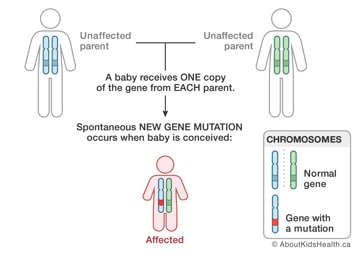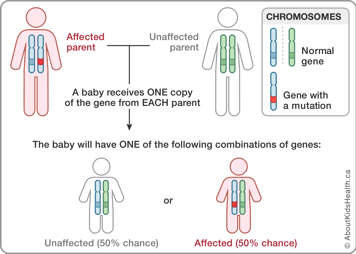What is tuberous sclerosis complex (TSC)?
Tuberous sclerosis complex (TSC) is a genetic disorder that causes the growth of non-cancerous (benign) tumours in many different parts of the body, including the brain, skin, eyes, heart, kidneys and lungs. These tumours can cause a wide range of symptoms depending on their location and size. Common symptoms of TSC include seizures, intellectual disability, behavioural problems, skin abnormalities and eye problems.
TSC affects an estimated one in 6,000 newborns and approximately one to two million people worldwide. It is caused by variations in either of two genes, TSC1 or TSC2. The TSC1 gene is located on chromosome 9 and produces a protein called hamartin. The TSC2 gene is located on chromosome 16 and produces a protein called tuberin. Both hamartin and tuberin play a role in regulating cell growth and preventing the formation of tumours. Most cases of TSC are caused by new gene variations; however, in some cases, TSC can be inherited from a parent who carries the gene variant.
Symptoms of tuberous sclerosis complex
TSC is a complex disorder that affects multiple organs and systems in the body. The symptoms of TSC can vary greatly from person to person and can range from mild to severe. Some common symptoms of TSC include:
- Skin abnormalities: small, red or skin-colored bumps (angiofibromas); leathery, yellowish-brown patches (shagreen patches); and small bumps on the fingers and toes (ungual fibromas).
- Brain abnormalities: seizures, intellectual disability, and behavioural problems; a build-up of fluid in the brain (hydrocephalus); and a type of brain tumour called subependymal giant cell astrocytoma.
- Heart abnormalities: tumours of the heart muscle (cardiac rhabdomyomas), which can lead to heart rhythm problems (arrhythmias) or congestive heart failure.
- Kidney abnormalities: kidney cancer (renal cell carcinoma) or kidney cysts.
- Lung abnormalities: a condition that affects the lung's air spaces and causes breathing difficulties (lymphangiomyomatosis).
- Eye abnormalities: tumours of the retina (retinal hamartomas) or clouding of the lens of the eye (cataracts).
- Behavioural problems: attention deficit hyperactivity disorder (ADHD), autism spectrum disorder, or mood swings.
- Learning disabilities or intellectual disability.
Tuberous sclerosis complex is a genetic condition

DNA carries a person’s genetic information. DNA is organized into structures called chromosomes. Each cell of the body contains the same number of chromosomes and all a person’s genetic information. Humans have 46 chromosomes arranged in 23 pairs, with two copies of each chromosome.
Chromosomes carry all of our genes. Genes determine how a person will grow and develop. Variations in genetic information (such as a chromosome mutation) can lead to medical and developmental problems. How a person’s development or health will be affected depends on which genetic material has a variation.
Causes of tuberous sclerosis complex
Chromosome variation
TSC is caused by variations in either of two genes, TSC1 and TSC2. These genes are responsible for producing proteins that regulate the growth of cells and help prevent the formation of tumours. When variations occur in either of these genes, the proteins they produce are altered or do not work properly, leading to uncontrolled cell growth and the formation of benign tumours in various organs.
How did my child get tuberous sclerosis complex?
Most of the time, TSC is the result of a new genetic variation that occurs when a child is conceived. This is called a de novo variant and occurs by chance in either the egg or the sperm. A de novo variant is not caused by anything the parents did before or during the pregnancy. For parents who have a child with a de novo variant, the chance of having another child with TSC is low.

In some people with TSC, the gene variant is inherited from a parent. Sometimes, a parent might not know that they have TSC until after they have a child diagnosed with this condition. A person who has TSC has a 50% chance (1 in 2) of having a child with TSC.

You can speak to a genetic counsellor to discuss information regarding how TSC happened in your family and your chances of having a child with TSC.
How TSC typically progresses (natural course)
Before birth or early infancy
- Sometimes, signs of TSC can be seen before birth on prenatal scans, like heart tumours (rhabdomyomas).
- In babies, seizures (especially a type called infantile spasms) are often the first noticeable symptom.
Childhood
- Children may have slower than expected development, learning difficulties, or behaviour patterns and characteristics seen in children with autism spectrum disorder.
- Skin changes, like light patches or small bumps, may appear.
- Seizures are common and may continue or change in type.
Teen years to adulthood
- Tumours may grow in the kidneys, which can cause pain, bleeding, or high blood pressure.
- Lung problems may develop, especially in women.
- Some people may have behavioural or mental health issues, like anxiety or aggression.
Later life
- Many people live into adulthood with TSC, but they may need ongoing monitoring and treatment.
- Some tumours can cause serious complications if not managed, especially in the brain or kidneys.
- With proper care, many people with TSC have a normal or near-normal life span.
Important notes
- No two people with TSC are the same. Some have very mild symptoms without much effect on day-to-day life, while others may need lifelong support.
- There is no cure for TSC, but treatments like medication, surgery and therapy can help manage symptoms and improve quality of life.
How tuberous sclerosis complex is diagnosed
Your child’s health-care provider will conduct various testing before confirming a diagnosis of TSC. Below are some of the tests your child might be given.
Physical exam
- Eye exam – to check for eye abnormalities
- Skin exam – to look for abnormal growths or patches of pale or thickened skin
Imaging tests
- MRI – to detect tumours in the brain or kidneys
- Ultrasound – to detect tumours in the kidneys, heart or lungs
- Electroencephalogram (EEG) – to detect abnormal electrical activity within the brain
- Electrocardiogram (ECG) – to detect abnormal electrical activity in the heart
Genetic testing
- Genetic testing for variations in TSC1 and TSC2 genes
Genetic testing may show whether your child’s TSC1 or TSC2 gene has been affected and how the DNA sequence has been changed. A negative DNA test result does not rule out a diagnosis of TSC; however, a positive result will confirm a diagnosis.
You and your family members may also participate in genetic testing to confirm your own genetic status. If you are pregnant, there are prenatal tests that can detect TSC as well.
Treatment
Although there is no cure for TSC, symptoms can be treated and managed with the help of various health-care specialists. Regular testing is important for people with TSC to monitor their organ functions. Depending on where tumours are located and if they cause your child problems, they can be surgically removed or shrunk with medicines. Other symptoms like seizures, skin problems, high blood pressure and lung problems can also be managed with medicines; and developmental delays and behavioural problems can be managed with various therapies. People with TSC may need continued support in some aspects of their life throughout adulthood. With this support, people with TSC can lead happy, productive lives.
References
Zaroff CM, et al. Cognitive and Behavioral Correlates of Tuberous Sclerosis Complex. J Child Neurol. 2004 Nov;19(11):847-52.